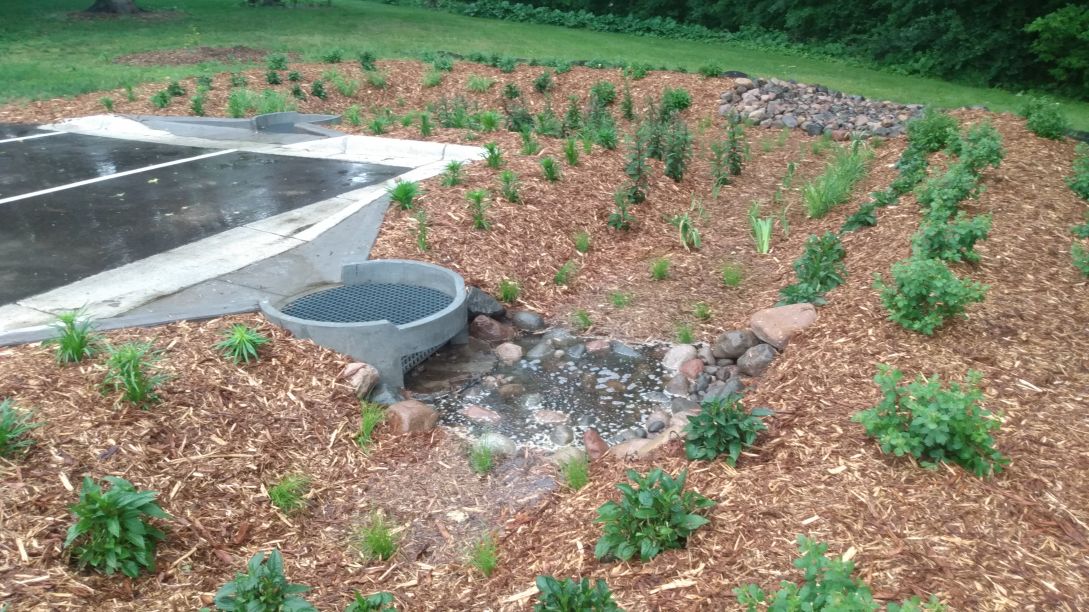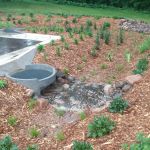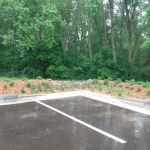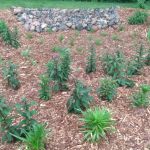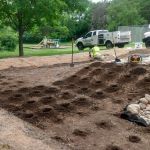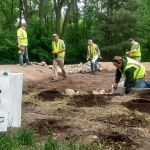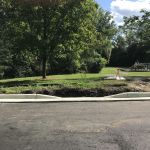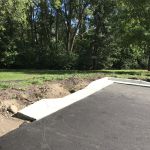Bridgewood Park Curb-Cut Raingarden
Quick Facts:
- .22 acres of impervious area (pavement) drains into the Bridgewood raingarden, and .26 pervious area (grass, trees, etc.)
- The raingarden removes about 90% of the nutrients and sediment that comes from its drainage area.
- The raingarden is 785 square feet and has a max depth of 9".
- The runoff coming from Bridgewood park drains into an adjacent wetland, and that water eventually connects to Lambert Creek and East Vadnais Lake.
Funding:
This effort was funded in partnership with the City of Vadnais Heights, Watershed-based Implementation Funding Program from the Board of Water and Soil Resources (BWSR), and the VLAWMO Landscape Level 2 grant program.
Reasons for project:
- To support the health, longevity, and holding capacity of the wetland adjacent to Bridgewood Park.
- To support the wetland adjacent to Bridgewood Park in its ability to support Lambert Creek and East Vadnais Lake.
- To reduce stress on downstream wetlands and lakes caused by nutrient and sediment loading.
- To help Vadnais Heights meet its stormwater improvement and volume reduction goals.
- Contribute to a high quality of life for community and the environment as outlined by the City of Vadnais Heights Parks and Recreation.
- Park beautification in a high-use public space.
Construction:
- The construction process started with removing a portion of bituminous pavement and a slab of concrete on the edge of the parking lot. The concrete slab was replaced to form a new walkway that includes an easy access pedestrian ramp.
- The design of the raingarden was completed in partnership with the Ramsey County Soil and Water Conservation Division.
- Two “Rain Guardians” act as the intakes for stormwater entering the raingarden. These are also known as a pre-treatment tool because they capture sediment, leaves, and other debris before they washes into the raingarden basin.
- The raingarden was excavated as deep as 12” down. This reduced the soil compaction that was there before construction from the previous parking lot. The basin allows for runoff infiltration at the site.
Native plants in the raingarden include:
- Fox sedge, Joe-Pye Weed, Gayfeather (Blazing Star), Switch Grass, Black-eyed Susan, Little Bluestem, Red Twig (Red-Osier) Dogwood, Blueflag Iris, and Black Chokeberry.
Results:
The raingarden provides a valuable space for stormwater treatment and storage, which supports the function and longevity of the nearby wetland and Lambert Creek. The native plants provide habitat for pollinators while also beautifying the parking lot. Using Minimal Impact Design Standards (MIDS), it's estimated that each year, this raingarden:
- Stores 4,643 bathtubs of stormwater, or 1 football field about 1/2 ft deep
- Removes 85 lbs of sediment from washing into the nearby wetland and Lambert Creek.
- Removes .47 lbs of total phosphorus (1 lb of TP can create 500 lbs of algae)
Bridgewood Park Raingarden Interpretative Sign
Video: Lambert Creek Drainage System

Legislative Coordinating Commission

Project Image Gallery
Search projects
Birch Lake Aquatic Invasive Species Efforts
Efforts to remove Eurasian Watermilfoil and Curly-leaf Pondweed
4th and Otter Woodland Restoration
A woodland restoration at a key location adjacent to Birch Lake in White Bear Lake.
Birch Lake Sand-Iron Stormwater Filter
An iron-enhanced sand filter at the intersection of 4th St. and Otter Lake Road. The filter helps reduce nutrients entering Birch Lake with stormwater runoff.
Birch Lake North Shoreline Restoration
A 150 foot stretch of lakeshore on Birch Lake, in White Bear Lake was improved in the summer of 2010. In 2011-2012, an additional 700 feet of shoreline was restored on either side of the original planting area.
Charley Lake Channel Restoration
The channel between Charley Lake and Pleasant Lake in North Oaks was showing signs of serious erosion.
Deep Lake Channel Restoration
This project will restore approximately 125 feet of shoreline in the Deep Lake Channel, just before it enters Pleasant Lake. The project will be completed in Fall 2015.

